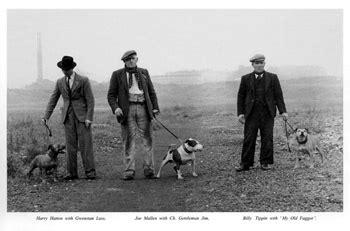A Stafford By Any Other Name
Every so often, you hear people ask why some insist on calling Staffordshire Bull Terriers “Staffords,” avoiding the use of those other alternative short names for the breed. Most of the time you never get a serious answer, other than personal opinion: “That’s just the way it has always been!” And then it turns into an argument of semantics. However, there are actually a variety of reasons why “Stafford” was, and continues to be, the diehard go-to name for so many serious enthusiasts of the breed.
The oldest and simplest line of reasoning actually predates the dogs by about 500 years: Early people of Staffordshire, England carried the family name “Stafford.” Was the land named after them or were they named after the land? Who knows, but in the very early days (15th century), if you were a “Stafford” by name you were from, or of, the County of Staffordshire. The County Town (county seat) of Staffordshire is Stafford, and sometimes the entire county of Staffordshire is just referred to as “Stafford.” Items from the County of Staffordshire, like the region’s famous pottery, are often referred to by shortened common names, such as “Stafford pottery,” as opposed to the full “Staffordshire pottery,” which is what you will find printed on each piece. The Staffordshire Knot which appears on everything from the county seal to pub signs, family crests to hat pins, is commonly called the Stafford Knot. Some say the knot is named after Lady Joan de Stafford (“of Stafford” – Staffordshire) who used it in her family seal. There is at least a 600-year history of the term “Stafford” being the simple, abbreviated term for anything from or of Staffordshire County. This is one of the deep-rooted reasons some people still insist that the Staffordshire Bull Terrier is the “Stafford” and not the “Staffy” nor the “Staffy Bull.” Had it been “Lady Joan de Staffy” who brought her family crest to the land in the 15th century, perhaps history might direct the use of alternative nomenclature today.
There’s another reason that many people in the breed prefer the term Stafford. In the United States the most popular breed the “pit bull.” Wait a minute — no it isn’t. Not by any registry kept on this planet, at least. However, any mix of dog with a slightly blocky head, short coat and muscles that ends up in a shelter is called a “pit bull” in this country. Most of them have American Pit Bull Terrier in them somewhere, but the most commonly seen dog has become more of a style of cur dog, as my granddad who raised American Pit Bull Terriers would say, than a breed. No matter what they have been mixed with over the years, though, it’s always the pit bull part that becomes their identity. The shelters are full of them. The classifieds are full of them, and the internet is full of them, particularly when they bite something or someone. Now, let’s jump the pond.
In 1991 Britain’s Dangerous Dog Act banned pit bulls and effectively eliminated them from that country. The Staffordshire Bull Terrier, of course, was not a part of the ban. Still, the breed ended up facing a similar issue in Great Britain that we have with the American Pit Bull Terrier here. Take six to 10 generations of mostly Stafford, mixed with the occasional neighbor’s Jack Russell, throw in a small Lab-mix here or there, and what happens when they end up on the street, in the shelter, or on the news for biting someone? It’s one of those blocky-headed, short-haired muscly dogs you see everywhere – it’s a “Staffy.” The term has become a catch-all for any backyard dog that looks mostly like a Staffordshire Bull Terrier, or a mix thereof, just like “pit bull” is used in the United States.
This is particularly true amongst those who have experience working with shelters and rescues. The term has even caught on in the United States. I was watching one of those dog rehab shows on TV the other day. It was supposed to feature a Staffordshire Bull Terrier on the episode, but when I tuned in, it ended up being a small pit bull that they kept calling a “Staffy.” Because of the generalizations and how loosely the term “Staffy” is thrown about, you will often find conformation breeders in the UK have a preference for the more traditional term “Stafford,” which tends to remove their dogs from the image that comes to mind of the typical backyard or shelter dog. Whether or not a person thinks it’s pretentious to distance themselves from the common vision of a backyard pet or shelter dog by using the term traditionally passed down in conformation circles for fancy purebred Staffordshire Bull Terriers, well, that’s up to the individual.
The third reason I want to share for why the term Stafford is preferable is perhaps the least enthralling, but it’s the most important one to some people, for reasons that can’t be explained through history or sociolinguistics. At its core, it’s rather simple: Their mentor told them the breed is to be called “Stafford.” Out of respect for their mentors, and for that reason alone, they carry the name Stafford with honor.
–Jason Nicolai (Homebrewed Staffords)
(written for SBTCA, submitted to AKC Gazette, republished here & on Wavemaker Staffords with permission)
